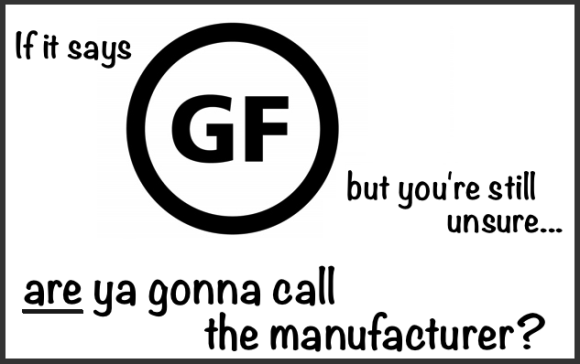“For the most complete and accurate information, contact the manufacturer directly.” Some version of this advice appears in every introduction to gluten- or allergy-free living worth reading—and for good reason. Getting the answer straight from the source allows you to dodge cross-contamination bullets and sample new products with confidence. It’s great!
So why does it feel so much like homework? Much like SAT vocab drills, it’s a chore that can only help me, yet still seems unbearable. I use every excuse to avoid it:
- I’m busy.
- I’ll just buy some other product I know is fine.
- Customer service isn’t available because it’s a weekend/evening/holiday/they prolly just won’t pick up, man.
- If I take it home, call, and find out I can’t eat it, I won’t want to return it. In fact, I know I wouldn’t return it. That’s wasteful!
- All that information is online anyway.
- Is this really my life?!
I’m curious: Am I the only one who feels this way?
Personally, if a label isn’t telling me what I need to know, I always turn to Google first. (It’s like the Seamless ad says: “The best part about having a smartphone is never having to call anyone.”) For most products, you can find bloggers who have written about their experience contacting the manufacturer, or lists on About.com, or debates on forums. Sometimes the manufacturer’s website even pops up with a handy FAQ (though said website is invariably mobile-unfriendly to the extreme). A lot of times, that’s probably enough. But not always.
You might think no one would find it in his/her company’s best interests to stop producing a line of gluten-free products or start processing a previously allergen-free food on contaminated lines, but you’d be wrong. Manufacturers change stuff all the time, for reasons both clear and abstruse (though almost all, I’d wager, connected to money). Case in point: our go-to gluten-free dried beans provider, Shiloh Farms, recently discontinued its entire line of GF legumes due to supplier costs.* (They still sell a few other certified items.)
It goes the other way, too, of course. Brands cited as no-gos in ancient Celiac.com threads have cleaned up their act, and both small and mainstream companies introduce new goods every day. Even the mighty About.com Guide Jane Anderson can’t keep pace with every recipe reformulation and label change. (She does, of course, advise us to “always, if in doubt about the gluten-free status of a product, contact the manufacturer’s customer service personnel directly.”)
We may be only 11 years away from falling in love with our computers’ operating systems (according to Spike Jonze) and 4 to 10 years away from a cure for celiac disease (according to Stefano Guandalini), but even so, the best source for accurate, up-to-date information isn’t necessarily the Internet.

Unlike bittersweet photography subjects, we don’t have to confine all our interactions to typing and swiping. Hey, food issues are isolating enough as it is!
Photo © Shinichi Higashi | Flickr
You don’t always need to contact the manufacturer. You can look for reassuring label claims, trustworthy companies, and reliable certification organizations (though we all have slightly different ideas of what those are). We’re also getting ever closer to the time when manufacturers officially can’t put “gluten-free” on a label without it being, you know, true.
Of course, even if you trust a brand, you should check labels for anything new and troubling. You don’t, however, have to call every time (unless you’re in dire need of a hobby).
On the other hand, when:
- something—like popcorn—should be gluten-free, but doesn’t say it is
- a label includes that sneaky GF-in-a-circle near-copy of the “certified” logo
- you’re holding two cans of honey-roasted mixed nuts made by the same company and only one says it “may contain wheat”
- you want to know why, in the name of god, Shiloh Farms would be so cruel as to take away your one source of dried chickpeas, out of which falafel absolutely must be made
- you’ve read EVERYWHERE that egg- and bunny-shaped chocolates are usually wheat-contaminated, but you’ve found the one bag in the store that doesn’t say it is, and you need to be sure
. . . well. That’s when you call the manufacturer. Or email, if it’s available and you don’t mind waiting a day for a response. I prefer email, because I hate waiting on hold, like getting a response in writing, and am antisocial; but I do force myself to call sometimes, too.
And, you know what? In the end, it is a chore, but it’s a satisfying chore. Sometimes, sadly, you learn you can’t eat that thing (in which case—woohoo!—you didn’t waste your money on poison!). But other times, you learn you can.
You learn, for example, that Soyboy’s online FAQ is out of date, and their products marked “GF” are not processed on lines with wheat. You learn you can open that tempeh, turn it into a Cajun stir-fry way too spicy for your sister to enjoy (sorry), and chow down. And that’s when it all—hold music included—becomes worth it.

When do you pick up the phone to call a manufacturer? Or do you prefer email? (Don’t be afraid to show me up, if you’re actually a responsible adult who makes phone calls and stuff.) Have you ever had a really negative, or especially positive experience with this?
*How do I know the legumes were canceled due to supplier costs? Because I contacted the manufacturer directly! Duh! And I’m glad I did. Although I was disappointed not to learn it was all some big mistake, I was pleased to hear they’re seeking new suppliers of gluten-free garbanzos. Falafel and I are not, I hope, through for good.


 I’m here again to remind you that more than magic runs in the blood of J. K. Rowling’s wizarding folks. We talked about Moaning Myrtle
I’m here again to remind you that more than magic runs in the blood of J. K. Rowling’s wizarding folks. We talked about Moaning Myrtle